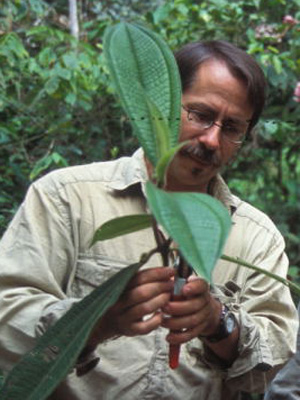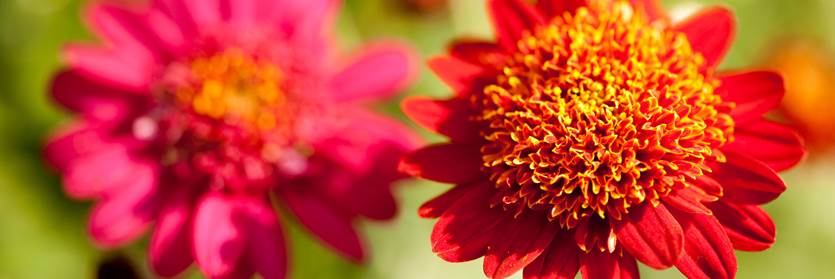Spotlight on: Douglas Daly, Ph.D.
Posted in People, Science on March 25 2009, by Plant Talk
During The Orchid Show: Brazilian Modern, Plant Talk takes a look at some of the research and conservation efforts of The New York Botanical scientists whose work is focused in Brazil. This interview was conducted by Jessica Blohm, Interpretive Specialist for Public Education.
 Dr. Doug Daly examines the ant domatia (chambers) of a Tococa (Melastomataceae) in Acre, Brazil. Ants live and reproduce in the swollen leaf petioles, and in return they protect the plant from herbivores. Photo by Rogerio Reis/Black Star
Dr. Doug Daly examines the ant domatia (chambers) of a Tococa (Melastomataceae) in Acre, Brazil. Ants live and reproduce in the swollen leaf petioles, and in return they protect the plant from herbivores. Photo by Rogerio Reis/Black Star“For me, the pure enjoyment of botany is in exploration, discovery, and especially solving puzzles,” says Dr. Douglas Daly, the B.A. Krukoff Curator of Amazonian Botany. A 30-year veteran of the Garden, he focuses on three avenues of research: flora and conservation of the Southwestern Amazon region, applications of plant taxonomy and systematics in ecology and public policy, and systematics of the Burseraceae, a diverse family of tropical trees and shrubs best known as a source of frankincense and myrrh.
Some of the mysteries he unravels help to conserve biodiversity in Brazil. For instance, his new book, Manual of Leaf Architecture, which he co-wrote with six other botanists, provides a detailed framework for describing leaves that is enabling loggers and conservationists to distinguish rare and endangered tree species in the field and the herbarium. At the same time, he has been the catalyst for bringing together the World Wildlife Fund-Brasil, the Forest Stewardship Council, the Tropical Forest Institute, the Brazilian Forest Service, and Amazonian state agencies to work together on overhauling the biodiversity aspects of the standards and procedures for managing certified forest operations as well as operations in national forests in Brazil.
His wide-ranging research in the southwestern Amazon, especially in Acre, Brazil, not only helps regional governments designate conservation areas, but it also produces vital information about useful plants that aids forest dwellers to better manage their resources for a more sustainable living from the forest. The book he published with his colleague Marcos Silveira in 2008, First Catalogue of the Flora of Acre, Brazil, is the first of its kind for any major part of the Brazilian Amazon.
A sample of his publications illustrates the scope of his work:
- The local branch: Toward better management of production forests in Amazonia.
- “Lost” plant collections from the Amazon 1. The 1899 expedition of Dr. Luigi Buscalioni. (w/ A. Miloza)
- Cacao and its relatives in South America: An overview of taxonomy, ecology, biogeography, chemistry, and ethnobotany. (w/ N. Bletter)
- A digital base map for studying the Neotropical flora. (w/ N. Bletter)
- Floristic aspects of the Rio Juruá basin: Botanical history, peculiarities, similarities, and importance for conservation. (w/ M. Silveira)
- Forests of the Rio Negro. (book edited w/ A. Oliveira)
- Lowland vegetation of tropical South America—an overview. (w/ J. Mitchell)
- The “black holes” of diversity—Studies in Acre reveal the precariousness of our knowledge of the Amazonian flora. (w/ M. Silveira)
- The role of the physician in medicinal plant research. (w/ Dr. C. Limbach)
- The National Cancer Institute Plant Collections Program: Update and implications for tropical forests.
“When you work with biodiversity, resource management, and conservation in Brazil, the scale is daunting and the stakes are very high,” says Doug. “But my Brazilian colleagues and the students we are training are so talented, dedicated, and resilient that I really believe we can make a difference in the future of the Amazon region.”

